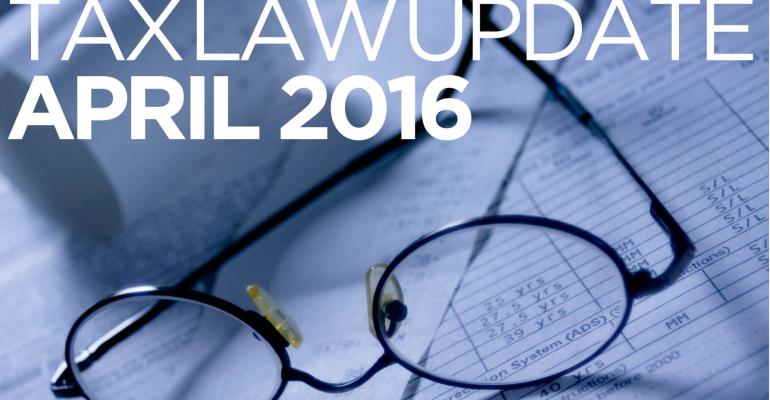• New proposed regulations relating to basis reporting—The Treasury has issued proposed regulations under Internal Revenue Code Sections 1014 and 6035 (among others) relating to basis reporting (T.D. 9757, March 3, 2016). These regulations implement the new basis reporting requirements that became law in
July 2015.
IRC Section 1014(f) provides that the basis of property acquired from a decedent can’t exceed the property’s final value for federal estate tax purposes. This rule coordinates with IRC Section 6035, which imposes reporting requirements on executors and other persons required to file an estate tax return to notify beneficiaries and the Internal Revenue Service of the basis of property received.
The proposed regulations clarify some issues raised by practitioners and commentators and, of course, introduce a few new ones. Several of the provisions are surprising. First, if there’s property that was discovered after filing the federal estate tax return or was omitted from the return for any other reason, and the executor reports such property on an estate tax return before the expiration of the assessment period, the basis will be the estate tax value that’s finally determined. If the property isn’t reported before the period of limitations on assessment expires, the final value under Section 1014(f) and the basis is zero. This proposed regulation seems not only to implement Section 1014(f), but also to substantively rewrite the section, as it now creates zero basis value. This results in significant income tax implications for beneficiaries receiving assets not properly reported on an estate tax return.
Another development is a new reporting requirement imposed on a beneficiary if he transfers the property he inherits from the estate to a related recipient (which is defined to include members of his family, an entity he controls or a grantor trust as to him) in a transaction in which the related recipient takes the basis of the original beneficiary. In this case, the beneficiary has a duty to file an information statement with the IRS and the related recipient within 30 days of the transfer. If the beneficiary disposes of the property before the final value is determined under Section 1014(c), the beneficiary must provide the executor with the statement, and the executor will send the related recipient (not the original beneficiary) the supplemental statement once the value is final. This provision considerably expands the reporting requirements to include not just executors but also beneficiaries.
The proposed regulations also introduce some confusion as to the beneficiaries to whom the executors must furnish the reporting statement. They provide that the executor must furnish the statement to each beneficiary, and the definition appears to include contingent beneficiaries. The definition is internally inconsistent and may be a mistake. If not, there may be a requirement to furnish the statement to contingent beneficiaries, which in many cases would be burdensome, impractical and useless.
On a positive note for executors, the proposed regulations state that the following don’t need to be included on the information statements: cash, income in respect of a decedent, tangible property (unless an appraisal is required because the value of an item exceeds $3,000) and property that’s sold or otherwise disposed of by the estate. However, if an executor isn’t sure what property will be used to satisfy a beneficiary’s interest, the executor must list all of the property that could possibly be used, which will result in duplicative reporting (not to mention providing the beneficiary with a lot more information than he would otherwise be entitled to and more than the decedent would wish).
Below is a summary of some of the less surprising provisions of the proposed regulations:
• If an executor has provided the basis information to a beneficiary for all property that may be used to satisfy the beneficiary’s interest, the executor doesn’t need to file a supplemental statement later to confirm which assets were actually received.
• Supplemental statements are required for certain changes such as: discovery of property not reported on a return; a change in the value of the property pursuant to an audit or litigation; a change in the identity of the beneficiary (due to death or disclaimer, for example); or the executor’s disposition of the property in certain cases.
• The filing requirements of Section 6035 don’t apply to federal estate tax returns filed only for the purposes of portability or the generation-skipping transfer tax.
• The regulations clarify that the basis under Section 1014(f) may be adjusted as a result of post-death events as allowed under other sections of the IRC (such as depreciation or amortization), and those basis adjustments won’t cause a taxpayer to violate the provisions of Section 1014(f).
• The basis consistency requirement applies only to property that increases the federal estate tax liability; property that qualifies for the charitable or marital deduction isn’t subject to these rules.
• If a taxpayer who receives property from an estate has an income tax event that requires him to report the basis of such property before the final value for Section 1014(f) is determined, and the final value is determined before the statute of limitations has expired for such income tax event, the IRS may assert a deficiency if the final value is ultimately less than the basis reported by the taxpayer.
• If the beneficiary is a trust, estate or business entity, the executor may provide the statement to the trustee, executor or entity and not to the beneficiaries or owners.






